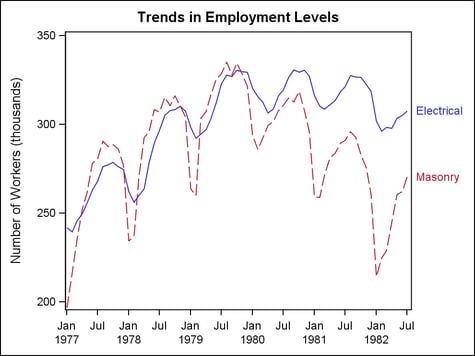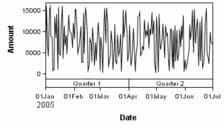Example Program and Statement Details
Example Program
proc template;
define statgraph layoutoverlay;
begingraph;
entrytitle "Trends in Employment Levels";
layout overlay / cycleattrs=true
xaxisopts=(display=(ticks tickvalues))
yaxisopts=(label="Number of Workers (thousands)");
seriesplot x=date y=electric /
curvelabel="Electrical"
curvelabellocation=outside;
seriesplot x=date y=masonry / curvelabel="Masonry"
curvelabellocation=outside;
endlayout;
endgraph;
end;
run;
proc sgrender data=sashelp.workers template=layoutoverlay;
run;
Statement Summary
The LAYOUT
OVERLAY statement builds a composite using one or more GTL-statements. You can specify one or more 2-D
plots within the layout, provided all plots can share the same type
of axes. You can also specify one or more insets, such as nested layout
statements (for example, LAYOUT GRIDDED), ENTRY statements, and legend
statements (CONTINUOUSLEGEND or DISCRETELEGEND).
-
All plot statements are rendered first. Plot statement results are always rendered in the plot area. The plots are stacked on top of one another in the order in which they are specified, with the last one on top. It is possible for one plot’s graphical data to obscure graphical data beneath it. You can control this by selectively ordering the plot statements, or by using transparency on the individual plots, or by doing both.
Generally,
the first specified plot determines the layout’s default axis
characteristics. To enable another plot to define the axis characteristics,
set PRIMARY=TRUE for that plot. For more information about the default
axis characteristics, see When Plots Share Data and a Common Axis.
Options
specifies the attributes
of the border line around the layout. See General Syntax for Attribute Options for the syntax
on using a style-element and Line Options for available line-options.
specifies whether the
default visual attributes of markers, lines, and fills in nested plot
statements automatically change from plot to plot. See Cycling Through Group Attributes in Overlaid Plots for more information.
the system looks at
the plots in the layout and tries to use the GraphData1 - GraphDataN
style elements to assign different visual properties to applicable
plots (scatter plots and series plots and others). For example, if
you overlay three series plots, the three series lines receive different
default visual properties (line pattern and color). These default
properties are determined by the next GraphDataN style element not
already used. Some plots in the layout do not participate in the cycling
(for example, reference lines and drop lines).
specifies the amount
of extra space that is added inside the layout border.
Default: The default padding for all sides is 0. Values without units are
in pixels (px). A unit must be provided if other than pixels.
Enables separate settings
for the left, right, top, and bottom padding dimensions. Use the pad-options to create non-uniform padding. These
options must be enclosed in parentheses. Each option is specified
as a name = value pair. Sides
not assigned padding are padded with the default amount.
| LEFT=dimension | specifies the amount of extra space added to the left side. |
| RIGHT=dimension | specifies the amount of extra space added to the right side. |
| TOP=dimension | specifies the amount of extra space added to the top. |
| BOTTOM=dimension | specifies the amount of extra space added to the bottom. |
specifies whether the
plot’s wall and wall outline are displayed.
Use the WALLCOLOR= option to control the fill color
of the wall.
specifies one or more
X axis options. For a list of options, see Axis Options for LAYOUT OVERLAY.
specifies one or more
X2 axis options. For a list of options, see Axis Options for LAYOUT OVERLAY.
specifies one or more
Y axis options. For a list of options, see Axis Options for LAYOUT OVERLAY.
specifies one or more
Y2 axis options. For a list of options, see Axis Options for LAYOUT OVERLAY.

